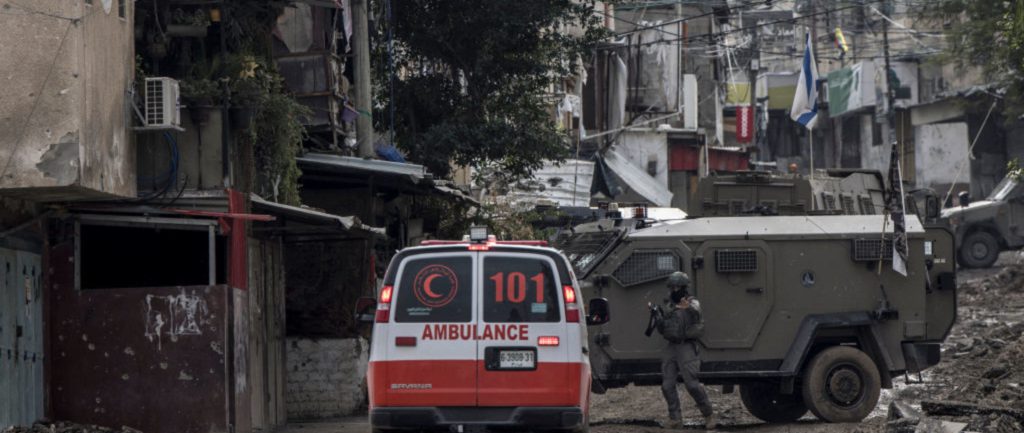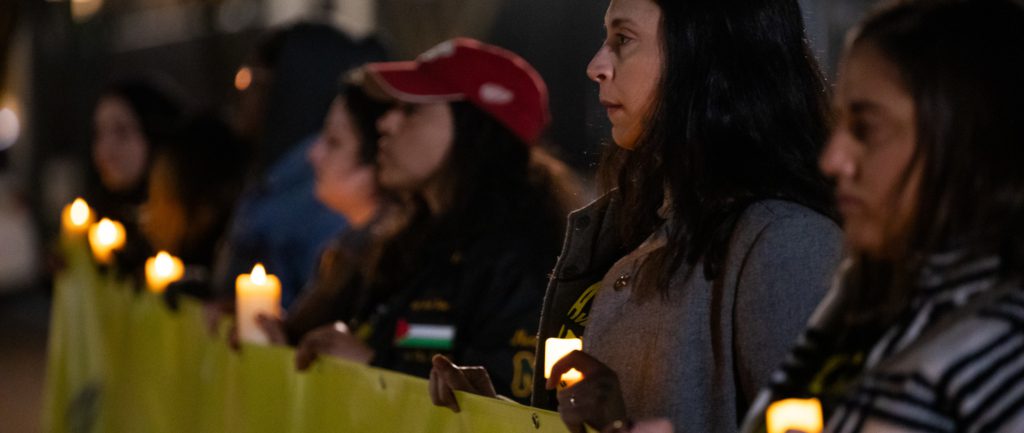The armed conflict between Israel and the Occupied Palestinian Territories (OPT) is one of the longest running in modern history. It’s also open to various interpretations, stories and misinformation. Learning more about the roots causes of violence in the Occupied Palestinian Territories and Israel is important to help us prevent future violations and for the respect of International Humanitarian Law.
Both international human rights law and international humanitarian law are fully applicable to the Occupied Palestinian Territories. Outside of the present conflict international human rights law is applicable in Israel, where Palestinians also live under a system of apartheid.
This Human Rights Education blog can help build your knowledge and understanding of the roots of the conflict and it provides links to additional education materials and a free online course if you wish to continue your learning.
Did the conflict begin on the 7 October 2023?
The present situation started with the surprise attack on Israel on 7 October 2023, in which Hamas and other armed groups killed at least 1,200 people and took over 200 hostages. But it is important to remember that one of the reasons for this conflict is Israel’s apartheid system against Palestinians living in Israel and the Occupied Palestinian Territories and against Palestinian refugees, and the inhumane acts committed by Israeli authorities with the purpose of creating this system and keeping it in place.
This conflict’s roots go beyond October 2023, with a long history of violations of human rights and international humanitarian law. Amnesty International has documented Israel’s system of oppression and domination against Palestinians, which it considers to be a violation of international law, amounting to apartheid.
“Apartheid” refers to an institutionalized regime of systematic oppression and domination by one racial group over another. These acts include unlawful killings, torture, arbitrary detention, segregation, dispossession and displacement, and the denial of the right of return to Palestinian refugees.
Does this system of Apartheid exist in Israel and the Occupied Palestinian Territories?
The term ‘Apartheid’ originally referred to a political system formally introduced in South Africa in 1948 by the National Party, where a regime of white minority rulers declared themselves officially superior to the majority of Black and other South Africans, and then proceeded to oppress and dominate them on the basis of race. South Africa’s apartheid system officially ended in the mid-1990s, but that doesn’t mean apartheid didn’t or isn’t happening elsewhere.
Apartheid is a series of human rights violations in the form of “inhuman acts committed for the purpose of establishing and maintaining domination by one racial group of persons over any other racial group of persons… and systematically oppressing them”. UN Apartheid Convention, 1973. Three main treaties that prohibit or explicitly criminalize apartheid are: 1. The International Convention on the Elimination of All Forms of Racial Discrimination (ICERD) of 1965 2. The International Convention on the Suppression and Punishment of the Crime of Apartheid of 1973 (Apartheid Convention)
The Rome Statute of the International Criminal Court (ICC) of 1998 3 Apartheid is a violation of public international law, a grave human rights violation, and a crime against humanity. It constitutes both a system (formed of laws, policies and practices) and a crime (specific acts).
Racial discrimination is a key element of the crime of apartheid, and manifests differently but clearly across different contexts where apartheid takes place.
When you hear the crime of apartheid what do you think of?
South Africa: The term ‘Apartheid’ originally referred to a political system formally introduced in South Africa in 1948 by the National Party, where a regime of white minority rulers declared themselves officially superior to the majority of Black and other South Africans, and then proceeded to oppress and dominate them on the basis of race. South Africa’s apartheid system officially ended in the mid-1990s, but that doesn’t mean apartheid didn’t or isn’t happening elsewhere.
Myanmar: Where the Rohingya people in Myanmar have been trapped in a vicious system of state-sponsored, institutionalized discrimination and racially based restrictions in law, policy and practice since 1962. “Caged without a roof” How do these systems impact the lives of people in practice?
Evidence of Apartheid
For Amnesty to determine whether the crime of apartheid has been committed, it examines all elements of international law defining the crime. All six elements of the crime must be met, supported by clear and compelling evidence.
- Inhumane acts as listed in international law are committed
- These inhuman or inhumane acts are committed against members of a racial group
- The racial group is a civilian population
- The acts were committed in the context of an institutionalized regime of systematic oppression and domination
- The acts were committed for the purpose of establishing and maintaining dominance
- The acts form part of a widespread or systematic attack

Amnesty’s research shows that Israeli authorities are enforcing a system of apartheid against Palestinians in Israel and the Occupied Palestinian Territories, and against Palestinian refugees and their descendants. Amnesty’s report “Israel’s apartheid against Palestinians: Cruel system of domination and crime against humanity” documents how Israel treats Palestinians as a separate and inferior racial group, segregating and oppressing them wherever it can exert control over their rights. What are the methods of apartheid? Read on to learn.
How can a group be more easily controlled?
Fragment and conquer: Discrimination and segregation describe the system which keeps Palestinians separated from each other in distinct territorial, legal and administrative domains. Fragmented life Since 2002, Israel has adopted a policy of prohibiting Palestinians from the West Bank and Gaza from gaining status in Israel or East Jerusalem through marriage, thus preventing family unification. Sumaia is Palestinian but was born and raised in Lod, in central Israel. She married her husband, who is from the Gaza Strip, in 1998 and he moved to live with her in Lod. In 2000, Sumaia and her husband began the process of applying for family unification, so they could live together legally. The family unification process took 18 years, during which the couple lived in fear and anxiety. Sumaia told Amnesty: “The government is controlling every detail of our lives, they are in our bedroom, in our homes. One of the most extreme cases was when they arrested my husband in 2004 while I was giving birth to one of my daughters…while I was in the delivery room, they arrested him!”
Dispossession of land and property: Decades of discriminatory land and property ownership rules and seizures, home demolitions and forced evictions by Israeli authorities. The Israeli government used certain discriminatory laws to take land from Palestinians in the Negev/Naqab area, particularly from the Bedouin communities, claiming it as government property. Now, even though Bedouins make up 35% of the population in the Southern District, they are only allowed to live in 1% of the area.
Deprivation of economic & social rights: Israel’s total blockade of Gaza since 2007 means Palestinians are cut off and facing severe restrictions on movement and availability of goods and resources, essentially isolating the area and the population. Abdul Nasser Al-Yazji was just two years old when he died on 28 August 2020 in the Gaza Strip. In the fall of 2019, when he was 18 months old, he was diagnosed with Ewing’s sarcoma cervical spine, a rare type of cancer in the neck. His parents tried to get him to a hospital in East Jerusalem to receive specialist treatment, but Israeli authorities never granted them a permit to leave in time.
Segregation and control: A system of discriminatory laws and policies that keep Palestinians restricted to enclaves – subjected to several measures that control their lives – and segregated. In mid-2002, the government of Israel began constructing a fence/wall in and around the West Bank, mostly on Palestinian land. The route has meant further appropriation of Palestinian land and the separation and segregation of Palestinian communities. In 2004, the International Court of Justice advised that the barrier was illegal.
Conclusion
The ongoing conflict and humanitarian catastrophe in Gaza stresses the critical importance of international humanitarian law in protecting civilians and other at-risk people during hostilities. A global plea for an immediate ceasefire resonates around the world, calling for all parties to halt the violence and safeguard human lives. Everyone involved in the conflict needs to follow and respect its rules, including state and non-state armed groups. Humanitarian assistance must be guaranteed to those in need. The whole world needs to keep an eye on the situation, stepping in when needed to make sure international humanitarian law rules are followed, to stop things from getting worse for the everyday people living through it.

Wondering what you can do to help?
For more ways to take action and further information on the current crisis and Amnesty’s work on Israel and the Occupied Palestinian Territories, check out the action toolkit on our country page.






















